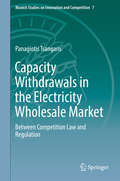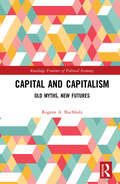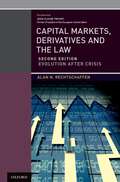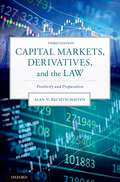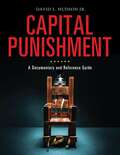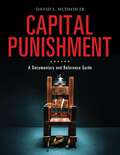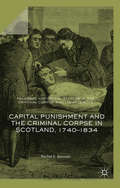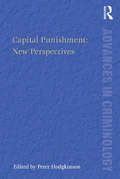- Table View
- List View
Capacity, Participation and Values in Comparative Legal Perspective
by Camillia Kong, John Coggon, Penny Cooper, Michael Dunn andWith contributions from an international team of experts, this collection provides a much-needed international, comparative approach to mental capacity law. The book focuses particularly on exploring substantive commonalities and divergences in normative orientation and practical application embedded in different legal frameworks. It draws together contributions from eleven different jurisdictions across Europe, Asia and the UK and explores what productive or unproductive values and practices currently exist. By providing a detailed comparison of how legal and ethical commitments to persons with disabilities are framed in capacity law across different national systems, the book highlights the values and practices that could lead to changes that better respect persons with disabilities in mental capacity regimes.
Capacity, Participation and Values in Comparative Legal Perspective
by Camillia Kong John Coggon Penny Cooper Michael Dunn Alex Ruck KeeneWith contributions from an international team of experts, this collection provides a much-needed international, comparative approach to mental capacity law. The book focuses particularly on exploring substantive commonalities and divergences in normative orientation and practical application embedded in different legal frameworks. It draws together contributions from eleven different jurisdictions across Europe, Asia and the UK and explores what productive or unproductive values and practices currently exist. By providing a detailed comparison of how legal and ethical commitments to persons with disabilities are framed in capacity law across different national systems, the book highlights the values and practices that could lead to changes that better respect persons with disabilities in mental capacity regimes.
Capacity Withdrawals in the Electricity Wholesale Market: Between Competition Law and Regulation (Munich Studies on Innovation and Competition #7)
by Panagiotis TsangarisThis book examines the issue of capacity withdrawals in the electricity wholesale market. Electricity generators can exercise market power in the wholesale market either by withdrawing generation capacity, or by pricing above competitive levels in order to achieve a higher market price and, thereby, increase revenues. After a comprehensive explanation of capacity withdrawal practices and the issues that arise when proceeding under competition law, the book analyses whether an increased state of transparency, as provided for in the REMIT and Regulation 543/2013, could facilitate the efficient functioning of electricity wholesale markets and the investigation of capacity withdrawal practices. It also examines the effect of the prohibition of market manipulation as prescribed in the REMIT in dealing with abusive capacity withdrawals in the electricity wholesale market.
The Cape Town Convention: A Documentary History (Hart Studies in Commercial and Financial Law)
by Anton DidenkoThis book is the first detailed and comprehensive research of the history of the Cape Town Convention and its protocols. It critically engages with the challenges faced by the developers of this treaty, analyses thousands of pages of archived materials and derives important lessons for the development of transnational commercial law globally. The book is an invaluable addition to the existing literature on the Cape Town Convention. It also informs the debate about harmonisation of secured transactions regimes generally, and as such will be of interest to academics, legal practitioners and the judiciary involved in secured transactions law around the world. Practising lawyers will better understand the rationale behind the key provisions of the Cape Town Convention, while the treaty-making lessons will assist governmental officials, representatives of international organisations and legal advisors engaged in harmonisation of commercial law.The text covers all four protocols to the Cape Town Convention, including the MAC Protocol adopted on 22 November 2019 in Pretoria.
The Cape Town Convention: A Documentary History (Hart Studies in Commercial and Financial Law)
by Anton DidenkoThis book is the first detailed and comprehensive research of the history of the Cape Town Convention and its protocols. It critically engages with the challenges faced by the developers of this treaty, analyses thousands of pages of archived materials and derives important lessons for the development of transnational commercial law globally. The book is an invaluable addition to the existing literature on the Cape Town Convention. It also informs the debate about harmonisation of secured transactions regimes generally, and as such will be of interest to academics, legal practitioners and the judiciary involved in secured transactions law around the world. Practising lawyers will better understand the rationale behind the key provisions of the Cape Town Convention, while the treaty-making lessons will assist governmental officials, representatives of international organisations and legal advisors engaged in harmonisation of commercial law.The text covers all four protocols to the Cape Town Convention, including the MAC Protocol adopted on 22 November 2019 in Pretoria.
Capital and Capitalism: Old Myths, New Futures (Routledge Frontiers of Political Economy)
by Rogene A. BuchholzCapitalist societies need to undergo major change to provide for the material needs of all the people who work within the system, not just the 1 percent. They have become dysfunctional and need a different kind of orientation to continue in existence. Instead of creating wealth, which is what they are supposed to accomplish, they have created nothing but debt for the past several decades and are now in serious trouble with regard to finding the wherewithal to keep on functioning as viable societies that can provide job opportunities for their workers and the promise of a better life in the future for their citizens. The coronavirus pandemic has exposed just how many people live paycheck to paycheck and have not been able to accumulate any kind of savings. The 1 percent, meanwhile, have benefited greatly and have vastly increased their wealth over the past several decades. This book does not advocate the need to turn to a form of socialism, however, to give most workers a chance at a decent life for themselves. What is needed is a redefinition of capitalism to make it work for everyone. Capital and Capitalism seeks to uncover various myths about capitalism that hinder our ability to change the system and discuss the task of redefining capitalism by examining where neo-liberalism went wrong and what role restructuring the corporation along stakeholder lines can play in making capitalism more responsive to the entire society.It will be of interest to researchers, academics, and students in the fields of business and society, leadership, and business ethics.
Capital and Capitalism: Old Myths, New Futures (Routledge Frontiers of Political Economy)
by Rogene A. BuchholzCapitalist societies need to undergo major change to provide for the material needs of all the people who work within the system, not just the 1 percent. They have become dysfunctional and need a different kind of orientation to continue in existence. Instead of creating wealth, which is what they are supposed to accomplish, they have created nothing but debt for the past several decades and are now in serious trouble with regard to finding the wherewithal to keep on functioning as viable societies that can provide job opportunities for their workers and the promise of a better life in the future for their citizens. The coronavirus pandemic has exposed just how many people live paycheck to paycheck and have not been able to accumulate any kind of savings. The 1 percent, meanwhile, have benefited greatly and have vastly increased their wealth over the past several decades. This book does not advocate the need to turn to a form of socialism, however, to give most workers a chance at a decent life for themselves. What is needed is a redefinition of capitalism to make it work for everyone. Capital and Capitalism seeks to uncover various myths about capitalism that hinder our ability to change the system and discuss the task of redefining capitalism by examining where neo-liberalism went wrong and what role restructuring the corporation along stakeholder lines can play in making capitalism more responsive to the entire society.It will be of interest to researchers, academics, and students in the fields of business and society, leadership, and business ethics.
Capital and Liquidity Requirements for European Banks (Oxford EU Financial Regulation)
by Bart P.M. Joosen, Marco Lamandini, Tobias TrögerPart of the Oxford EU Financial Regulation Series, this book analyses the harmonised legislative framework for capital adequacy and liquidity supervision in the Single Rule Book for European banks. It brings together leading experts in the field of prudential banking regulation and accounting to provide an in-depth analysis of the regulatory framework. Capital and Liquidity Requirements for EU Banks goes far beyond the existing rules and standards, not only by looking into the historical realisation of the European Single Rule Book (SRB) for capital adequacy and liquidity supervision, but also by going deeply into the background of the standards put forward by the Basel Committee for Banking Supervision, the global rule-maker for the financial sector. The insights provided into the historical and normative background are essential in order to facilitate a more constructive interpretation of the extensive rules of the SRB The book also delivers a deeper understanding of the various policy choices that Europe has made in the transposition of the Basel standards. An important reference source for all legal practitioners and scholars researching European financial regulation, this new volume provides an extensive representation of the key topics, affording the reader unique insights into the interrelation and the interplay of the various prudential rules and standards in Europe.
Capital and Liquidity Requirements for European Banks (Oxford EU Financial Regulation)
Part of the Oxford EU Financial Regulation Series, this book analyses the harmonised legislative framework for capital adequacy and liquidity supervision in the Single Rule Book for European banks. It brings together leading experts in the field of prudential banking regulation and accounting to provide an in-depth analysis of the regulatory framework. Capital and Liquidity Requirements for EU Banks goes far beyond the existing rules and standards, not only by looking into the historical realisation of the European Single Rule Book (SRB) for capital adequacy and liquidity supervision, but also by going deeply into the background of the standards put forward by the Basel Committee for Banking Supervision, the global rule-maker for the financial sector. The insights provided into the historical and normative background are essential in order to facilitate a more constructive interpretation of the extensive rules of the SRB The book also delivers a deeper understanding of the various policy choices that Europe has made in the transposition of the Basel standards. An important reference source for all legal practitioners and scholars researching European financial regulation, this new volume provides an extensive representation of the key topics, affording the reader unique insights into the interrelation and the interplay of the various prudential rules and standards in Europe.
Capital Markets, Derivatives and the Law
by Alan RechtschaffenPresident Obama recently called for a new financial regulation system in the United States. In order to understand the intricacies of new regulation, individuals must have a strong foundation in how capital markets function as well as how financial instruments and derivatives work. Capital Markets, Derivatives, and the Law provides readers with the foundation necessary to make informed, well-reasoned decisions about capital market participation, derivative utilization, and adherence to existing and future regulations. This publication is an essential guide for attorneys and business professionals looking for an accessible resource to better understand the legal and business considerations of capital markets and derivatives transactions. This book offers expert insight into how derivatives work. The author also explores the structures of derivatives as well as how they are regulated and litigated. In the complex world of the current capital market upheaval, this book provides useful definitions, case law examples, and insight into structures, regulation, and litigation strategies.
Capital Markets, Derivatives and the Law
by Alan RechtschaffenPresident Obama recently called for a new financial regulation system in the United States. In order to understand the intricacies of new regulation, individuals must have a strong foundation in how capital markets function as well as how financial instruments and derivatives work. Capital Markets, Derivatives, and the Law provides readers with the foundation necessary to make informed, well-reasoned decisions about capital market participation, derivative utilization, and adherence to existing and future regulations. This publication is an essential guide for attorneys and business professionals looking for an accessible resource to better understand the legal and business considerations of capital markets and derivatives transactions. This book offers expert insight into how derivatives work. The author also explores the structures of derivatives as well as how they are regulated and litigated. In the complex world of the current capital market upheaval, this book provides useful definitions, case law examples, and insight into structures, regulation, and litigation strategies.
Capital Markets, Derivatives and the Law: Evolution After Crisis
by Alan N. RechtschaffenDramatic failures in individual markets and institutions sparked a global financial crisis that resulted in political, social, and economic unrest. In the United States, a host of legislative acts have completely reshaped the regulatory landscape. Capital Markets, Derivatives and the Law: Evolution After Crisis investigates the impact of the financial crisis on capital markets and regulation. With an emphasis on the structure and the workings of financial instruments, it considers market evolution after the crisis and the impact of Central Bank policy. In doing so, it provides the reader with the tools to recognize vulnerabilities in capital market trading activities. This edition serves as an essential guide to better understand the legal and business considerations of capital market participation. With useful definitions, case law examples, and expert insight into structures, regulation, and litigation strategies, Capital Markets, Derivatives and the Law: Evolution After Crisis offers readers invaluable tools to make prudent, well-informed decisions.
Capital Markets, Derivatives, and the Law: Positivity and Preparation
by Alan N. RechtschaffenDramatic failures in individual markets and institutions sparked a global financial crisis that resulted in political, social, and economic unrest. In the United States, a host of legislative acts have completely reshaped the regulatory landscape. Capital Markets, Derivatives and the Law: Positivity and Preparation investigates the impact of the financial crisis on capital markets and regulation. With an emphasis on the structure and the workings of financial instruments, it considers market evolution after the crisis and the impact of Central Bank policy. In doing so, it provides the reader with the tools to recognize vulnerabilities in capital market trading activities. This edition serves as an essential guide to better understand the legal and business considerations of capital market participation. With useful definitions, case law examples, and expert insight into structures, regulation, and litigation strategies, Capital Markets, Derivatives and the Law: Positivity and Preparation offers readers invaluable tools to make prudent, well-informed decisions.
Capital Markets, Derivatives, and the Law: Positivity and Preparation
by Alan N. RechtschaffenDramatic failures in individual markets and institutions sparked a global financial crisis that resulted in political, social, and economic unrest. In the United States, a host of legislative acts have completely reshaped the regulatory landscape. Capital Markets, Derivatives and the Law: Positivity and Preparation investigates the impact of the financial crisis on capital markets and regulation. With an emphasis on the structure and the workings of financial instruments, it considers market evolution after the crisis and the impact of Central Bank policy. In doing so, it provides the reader with the tools to recognize vulnerabilities in capital market trading activities. This edition serves as an essential guide to better understand the legal and business considerations of capital market participation. With useful definitions, case law examples, and expert insight into structures, regulation, and litigation strategies, Capital Markets, Derivatives and the Law: Positivity and Preparation offers readers invaluable tools to make prudent, well-informed decisions.
Capital Markets Union in Europe (Oxford EU Financial Regulation)
by Danny Busch, Emilios Avgouleas and Guido FerrariniCapital Markets Union in Europe analyses the legal and economic implications of the European Commission's plans to form a Capital Markets Union (CMU) in Europe, which will have a major impact on financial markets and institutions both in the region and beyond. A detailed introductory chapter provides a broad overview of the various aspects and challenges of the CMU proposals, whilst thematically grouped chapters cover the following areas: (i) general aspects, (ii) Brexit, (iii) financing innovation, (iv) raising capital on the capital markets, (v) fostering retail and institutional investment, (vi) leveraging banking capacity to support the wider economy, (vii) facilitating cross-border investing, and (viii) comparative aspects of capital market integration. Written by world renowned experts in the fields of banking and capital markets, including respected academics, with broad practical experience, and leading practitioners, Capital Markets Union in Europe provides high-quality analysis of the legal and economic issues in a practical context.
Capital Markets Union in Europe (Oxford EU Financial Regulation)
Capital Markets Union in Europe analyses the legal and economic implications of the European Commission's plans to form a Capital Markets Union (CMU) in Europe, which will have a major impact on financial markets and institutions both in the region and beyond. A detailed introductory chapter provides a broad overview of the various aspects and challenges of the CMU proposals, whilst thematically grouped chapters cover the following areas: (i) general aspects, (ii) Brexit, (iii) financing innovation, (iv) raising capital on the capital markets, (v) fostering retail and institutional investment, (vi) leveraging banking capacity to support the wider economy, (vii) facilitating cross-border investing, and (viii) comparative aspects of capital market integration. Written by world renowned experts in the fields of banking and capital markets, including respected academics, with broad practical experience, and leading practitioners, Capital Markets Union in Europe provides high-quality analysis of the legal and economic issues in a practical context.
Capital Punishment: A Documentary and Reference Guide (Documentary and Reference Guides)
by David L. Jr.Each entry in this essential collection of primary resources on capital punishment features an authoritative introduction and analysis that helps provide crucial context for understanding the evolution of law and public attitudes toward the death penalty in America, from colonial times to the present.Showcasing key primary documents that illuminate the ongoing debate and turbulent history of capital punishment in the United States, this collection gathers a wide range of fascinating and momentous documents, including court decisions and transcripts, legislation, personal accounts and perspectives, congressional testimony, and government documents. Since these documents reflect all political perspectives and messaging, students will gain valuable insight into the evolution of public opinion and government policy on the death penalty in America. To better understand these documents, each primary source is prefaced with an introduction and followed by scholarly analysis. These documents and accompanying analysis complement one another, helping students gain a better and more accurate understanding of the viewpoints, convictions, and perspectives that have shaped American attitudes and practices toward capital punishment since the United States' earliest days.
Capital Punishment: A Documentary and Reference Guide (Documentary and Reference Guides)
by David L. Jr.Each entry in this essential collection of primary resources on capital punishment features an authoritative introduction and analysis that helps provide crucial context for understanding the evolution of law and public attitudes toward the death penalty in America, from colonial times to the present.Showcasing key primary documents that illuminate the ongoing debate and turbulent history of capital punishment in the United States, this collection gathers a wide range of fascinating and momentous documents, including court decisions and transcripts, legislation, personal accounts and perspectives, congressional testimony, and government documents. Since these documents reflect all political perspectives and messaging, students will gain valuable insight into the evolution of public opinion and government policy on the death penalty in America. To better understand these documents, each primary source is prefaced with an introduction and followed by scholarly analysis. These documents and accompanying analysis complement one another, helping students gain a better and more accurate understanding of the viewpoints, convictions, and perspectives that have shaped American attitudes and practices toward capital punishment since the United States' earliest days.
Capital Punishment: A Reference Handbook (Contemporary World Issues)
by Michael KronenwetterThis revised edition of a perennial bestseller, with more than 50 percent new material, is a much-needed overview of a hotly debated topic.Capital Punishment focuses on the use of the death penalty in the United States, its international status, and how foreign developments affect the country. It includes a history, a discussion of the controversies surrounding the death penalty, updated biographical sketches, and statistics. Key documents include the U.S. Supreme Court decision affirming capital punishment, a key dissent, Charles Dickens' 19th century view of the guillotine, and various papal and European Union decrees. It also includes a chronology, organizations, websites with further information, and an annotated bibliography.In this updated survey, a thorough overview of capital punishment, author Michael Kronenwetter reveals interesting facts, for example, under Roman law, death was the penalty for publishing "insulting songs" and disturbing the city's peace.
Capital Punishment (Historical Guides to Controversial Issues in America)
by Joseph A. Melusky Keith A. PestoThis balanced approach to legal precedent and moral argument regarding the death penalty presents the evidence so readers can reach their own informed conclusions.Capital Punishment examines the debate around the death penalty, raising questions and attempting to provide an even-handed examination of this controversial practice. The authors combine analysis of important issues with excerpts from landmark legal decisions, important documents, survey results, and empirical data. The first part of the book discusses the origins of the death penalty and traces its development from antiquity to contemporary times. Detailed statistical information about capital punishment is presented and discussed, and the death penalty is considered against a constitutional backdrop with various arguments—for and against—articulated. The second part of the book consists of three appendices. The first appendix presents an annotated list of important capital-punishment cases; the second supplies a more general chronological treatment of capital punishment; and the third provides a bibliographic essay directing readers to other relevant sources of interest. A thorough and insightful treatment, Capital Punishment provides both a summary of the current state of capital punishment and a discussion of areas of continuing controversy.
Capital Punishment: A Hazard to a Sustainable Criminal Justice System?
by Lill ScherdinAs most jurisdictions move away from the death penalty, some remain strongly committed to it, while others hold on to it but use it sparingly. This volume seeks to understand why, by examining the death penalty’s relationship to state governance in the past and present. It also examines how international, transnational and national forces intersect in order to understand the possibilities of future death penalty abolition. The chapters cover the USA - the only western democracy that still uses the death penalty - and Asia - the site of some 90 per cent of all executions. Also included are discussions of the death penalty in Islam and its practice in selected Muslim majority countries. There is also a comparative chapter departing from the response to the mass killings in Norway in 2011. Leading experts in law, criminology and human rights combine theory and empirical research to further our understanding of the relationships between ways of governance, the role of leadership and the death penalty practices. This book questions whether the death penalty in and of itself is a hazard to a sustainable development of criminal justice. It is an invaluable resource for all those researching and campaigning for the global abolition of capital punishment.
Capital Punishment: A Hazard to a Sustainable Criminal Justice System?
by Lill ScherdinAs most jurisdictions move away from the death penalty, some remain strongly committed to it, while others hold on to it but use it sparingly. This volume seeks to understand why, by examining the death penalty’s relationship to state governance in the past and present. It also examines how international, transnational and national forces intersect in order to understand the possibilities of future death penalty abolition. The chapters cover the USA - the only western democracy that still uses the death penalty - and Asia - the site of some 90 per cent of all executions. Also included are discussions of the death penalty in Islam and its practice in selected Muslim majority countries. There is also a comparative chapter departing from the response to the mass killings in Norway in 2011. Leading experts in law, criminology and human rights combine theory and empirical research to further our understanding of the relationships between ways of governance, the role of leadership and the death penalty practices. This book questions whether the death penalty in and of itself is a hazard to a sustainable development of criminal justice. It is an invaluable resource for all those researching and campaigning for the global abolition of capital punishment.
Capital Punishment and the Criminal Corpse in Scotland, 1740–1834
by Rachel E. BennettThis book is open access under a CC BY 4. 0 license. This book provides the most in-depth study of capital punishment in Scotland between the mid-eighteenth and early nineteenth century to date. Based upon an extensive gathering and analysis of previously untapped resources, it takes the reader on a journey from the courtrooms of Scotland to the theatre of the gallows. It introduces them to several of the malefactors who faced the hangman's noose and explores the traditional hallmarks of the spectacle of the scaffold. It demonstrates that the period between 1740 and 1834 was one of discussion, debate and fundamental change in the use of the death sentence and how it was staged in practice. In addition, the study provides an innovative investigation of the post-mortem punishment of the criminal corpse. It offers the reader an insight into the scene at the foot of the gibbets from which criminal bodies were displayed and around the dissection tables of Scotland's main universities where criminal bodies were used as cadavers for anatomical demonstration. In doing so it reveals an intermediate stage in the long-term disappearance of public bodily punishment.
Capital Punishment: New Perspectives (New Advances in Crime and Social Harm)
by Peter HodgkinsonThis collection asks questions about the received wisdom of the debate about capital punishment. Woven through the book, questions are asked of, and remedies proposed for, a raft of issues identified as having been overlooked in the traditional discourse. It provides a long overdue review of the disparate groups and strategies that lay claim to abolitionism. The authors argue that capital litigators should use their skills challenging the abuses not just of process, but of the conditions in which the condemned await their fate, namely prison conditions, education, leisure, visits, medical services, etc. In the aftermath of successful constitutional challenges it is the beneficiaries (arguably those who are considered successes, having been ’saved’ from the death penalty and now serving living death penalties of one sort or another) who are suffering the cruel and inhumane alternative. Part I of the book offers a selection of diverse, nuanced examinations of death penalty phenomena, scrutinizing complexities frequently omitted from the narrative of academics and activists. It offers a challenging and comprehensive analysis of issues critical to the abolition debate. Part II offers examinations of countries usually absent from academic analysis to provide an understanding of the status of the debate locally, with opportunities for wider application.
Capital Punishment: New Perspectives (New Advances in Crime and Social Harm)
by Peter HodgkinsonThis collection asks questions about the received wisdom of the debate about capital punishment. Woven through the book, questions are asked of, and remedies proposed for, a raft of issues identified as having been overlooked in the traditional discourse. It provides a long overdue review of the disparate groups and strategies that lay claim to abolitionism. The authors argue that capital litigators should use their skills challenging the abuses not just of process, but of the conditions in which the condemned await their fate, namely prison conditions, education, leisure, visits, medical services, etc. In the aftermath of successful constitutional challenges it is the beneficiaries (arguably those who are considered successes, having been ’saved’ from the death penalty and now serving living death penalties of one sort or another) who are suffering the cruel and inhumane alternative. Part I of the book offers a selection of diverse, nuanced examinations of death penalty phenomena, scrutinizing complexities frequently omitted from the narrative of academics and activists. It offers a challenging and comprehensive analysis of issues critical to the abolition debate. Part II offers examinations of countries usually absent from academic analysis to provide an understanding of the status of the debate locally, with opportunities for wider application.


